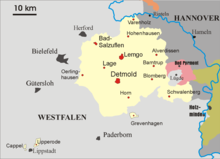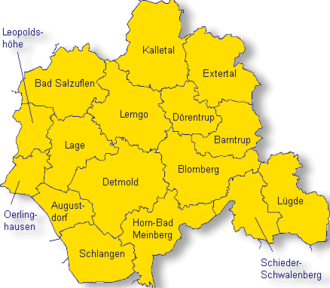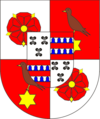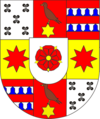Lip (country)
Lippe was a German state. From 1468 Detmold was the state capital .
The rule of the Lippe lords was first recorded in the 12th century. In 1528 the rule of Lippe was elevated to an imperial county, in 1789 to a principality . Until 1806 Lippe was a territory in the Lower Rhine-Westphalian Circle of the Holy Roman Empire , from 1806 to 1813 part of the Rhine Confederation , from 1816 to 1866 part of the German Confederation , from 1866 a member of the North German Confederation , from 1871 part of the German Empire and after 1919 a part democratically constituted Free State in the Weimar Republic. In 1947/1948, at the instigation of the British occupying power , the state of Lippe had to give up its centuries of independence and decided to integrate into the state of North Rhine-Westphalia, which was founded in 1946 .
The area of the former state of Lippe in its last territorial status largely corresponds (without the exclaves, among other things ) to today's district of Lippe in the administrative district of Detmold , both of which are administrative headquarters in Detmold. The district of Lippe (or Lipperland) forms the third and by far smallest part of the state of North Rhine-Westphalia alongside Westphalia and the Rhineland .
To distinguish it from other territories originally owned by the branch lines of the House of Lippe , in particular from Schaumburg-Lippe , Lippe was also called Lippe-Detmold .
Geographical location
The territory of the Free State of Lippe, often referred to as "Lipperland", is part of the historic Westphalia landscape . Since the political reorganization following the Congress of Vienna, it bordered the Prussian Province of Westphalia in the north, west and south (dissolved in North Rhine-Westphalia in 1946) and in the east on the Kingdom of Hanover , and since 1866 the Prussian Province of Hanover (dissolved in Lower Saxony in 1946 ). In addition, it bordered several exclaves of different areas in the northeast and southeast: the area around Pyrmont , which belonged to the Land of Waldeck until 1921 and then became part of Hanover, the Grafschaft Schaumburg , which was part of the Electorate of Hesse until 1866 , then to the Prussian Province of Hesse until 1932. Nassau belonged and then came to Hanover, as well as to the small Westphalian (most recently already North Rhine-Westphalian) exclave Lügde . Lippe itself had several small exclaves up to 1947: Cappel and Lipperode near Lippstadt (today districts of Lippstadt) and Grevenhagen, a few kilometers south of the heartland . All exclaves were surrounded by Westphalia.
Geographically, the Free State was largely northeast of the Teutoburg Forest (also called Lippischer Wald in the eastern part) and east of the Egge Mountains . The predominantly hilly, partly strongly cut terrain between Weser and Eggegebirge is called the Lipper Bergland , with the Köterberg as the highest point. The Lipperland was essentially part of the Weser Uplands . Only a smaller part of the area west of the Egge Mountains and southwest of the Osnings around Augustdorf was in the Westphalian Bay , which is characterized by the sandy heathland, the Senne . The largest rivers are the Weser, Werre , Bega and Emmer . The eponymous river Lippe rises near the Lippe state area in the Senne, but did not touch the heartland, only the exclaves Cappel and Lipperode near Lippstadt . However, the Lippe family comes from where it was able to gain its first territories. The city of Lippstadt was ruled as a condominium from 1666 to 1850 by the county or the principality of Lippe and the electorate of Brandenburg and the Kingdom of Prussia .
With a national territory of around 1200 km² and only 183,713 inhabitants ( 1939 census ), Lippe was one of the smaller member states of the German Empire . In terms of area, it was the sixth smallest state and the third smallest area state in the empire. The largest city in Lippe was the state capital and former residence city of Detmold with around 25,000 inhabitants.
story
Dominion and County of Lippe until 1789
Lippe was first mentioned in a document in 1123; a document names the nobleman Bernhard I as Bernhardus de Lippe . Until the Reformation, the rule of Lippe was in the spiritual sphere of activity of the Bishop of Paderborn . Successors acquired large areas of the county of Schwalenberg in the southeast and expanded their property northwards to the Weser by acquiring Varenholz and Langenholzhausen . In the 14th century the rule was divided and claimed by neighboring territories. The city of Lippstadt was transformed into an area administered jointly with the Grafschaft Mark . In the 15th century the county of Sternberg could be acquired. However, the county of Everstein was lost in a feud with the dukes of Braunschweig-Lüneburg . Lippe took part in the Soest feud as an opponent of the Archbishop of Cologne ; Parts of the rule were lost to the Landgraviate of Hesse and were then retained by the Count of Lippe as an inheritance.
In 1528 Simon V was awarded the title of Imperial Count; Lippe became a county. In the area of tension between the Catholic monastery Paderborn and the Lutheran Hesse, the counts decided to Protestantism, also under the influence of the Lippe cities. In 1538 the estates passed a Protestant church order for Lippe. Lippe was drawn into the Schmalkaldic War (1546–1547), which was lost to the Protestant side. As a result, Lippe became a direct Reichslehen . Count Simon VI. introduced the Reformed Confession in the so-called second Reformation . Only Lemgo remained Lutheran. Dynastically, Lippe was characterized by numerous legal disputes between the ruling Detmold line and younger lines (especially Lippe-Brake and Lippe-Alverdissen ). Count Philipp zur Lippe-Alverdissen founded the future Principality of Schaumburg-Lippe in 1647 with the inheritance of the northwest half of the County of Schaumburg . Like the entire region, Lippe was badly affected in the Thirty Years' War . The Lippe cities lost about two thirds of their population; in the countryside the loss was around 50 percent. In the Baroque and Enlightenment era, the Lippe rulers were only able to partially enforce their claim to power against the estates. The territory was too small and the inheritance disputes with side lines too big. Above all, however, the estates insisted on strong authorization rights in the state budget.
Principality of Lippe until 1918
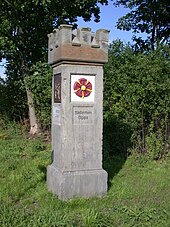
Leopold I (1767–1802) became the first Prince of Lippe in 1789. The principality survived the Napoleonic era in the Rhine Confederation . The principality, which was shaped by Calvinism, always adhered closely to Protestant Prussia and was thus able to maintain an independence, even if it was mostly only formal. In the German War of 1866 it was on the side of Prussia against the Austrian-led German Confederation . In 1866 it joined the North German Confederation and became part of the German Empire in 1871 . In the following years, several counts lines competed in the so-called Lippe succession dispute. The Reichsgericht in Leipzig decided the matter in 1897 in favor of Count Ernst zur Lippe-Biesterfeld . After the First World War , the principality became a democratic free state .
Free State of Lippe until 1945
After the November Revolution of 1918, a democratic free state emerged. State authority came from the people. A democratic constitution dated December 21, 1920, in which the legislative power lay with the Lippe state parliament . This elected a three-member state council, which was both head of state and government ( executive ) of the country. From 1919 to 1933 the SPD was the strongest party in the state parliament and led the three-member state presidium, initially under the leadership of Clemens Becker and from 1920 to 1933 by Heinrich Drake . The National Socialists used places in Lippe early on as a supposed “Germanic heartland” for their political purposes. During Nazi marches from all over the Reich, Lippe's unprecedented all-German significance was hyped up. The productions in Lippe, which was hit by the global economic crisis and high unemployment, impressed large sections of the population. Latent anti-Semitism and increasing agitation against political opponents also brought the NSDAP particularly high successes in local elections in the early 1930s. In the Lippe state elections on January 15, 1933, the Social Democrats lost their status as the strongest parliamentary group in the state parliament. The NSDAP won almost 40% of the vote, more than nationwide in the November 1932 Reichstag election . The Lippe results also had an impact on the Schleicher cabinet , which finally resigned on January 28, 1933. In Lippe, the NSDAP succeeded on February 7th in appointing two members of the state presidium and pushing Drake out of the government. With the appointment of Reich Governor Alfred Meyer in Detmold for Lippe and Schaumburg-Lippe from May 1933, the synchronization was completed earlier than in other parts of the Reich. At the same time, Hans-Joachim Riecke was appointed minister of state to head the Lippe state government. He was under the supervision of Alfred Meyer.
State of Lippe until 1947, incorporated into North Rhine-Westphalia
Lippe was occupied by US troops in April 1945 and assigned to the British zone of occupation when Germany was divided . The former Free States of Lippe and Schaumburg-Lippe were ruled under the joint Prime Minister Heinrich Drake . At the end of 1946, Schaumburg-Lippe was incorporated into the new state of Lower Saxony . For the remaining state of Lippe, the rest of state independence also ended after more than 800 years. The small state opted for North Rhine-Westphalia , which offered further concessions and incentives in the Lippe punctuation . By the British Military Ordinance No. 77 Lippe was incorporated into the state of North Rhine-Westphalia on January 21, 1947 and thus ceased to exist as a state. An initially planned referendum was never carried out.
Lippe as part of the state of North Rhine-Westphalia
Along with the northern Rhineland ( North Rhine-Westphalia ) and Westphalia, Lippe is the third part of the state of North Rhine-Westphalia. With the passing of the state law on March 10, 1953 on the state colors, flags and coats of arms, the Lippische Rose became part of the NRW coat of arms , which underlines this fact. The current part of the country has been administratively and politically a territorial unit since the district reform in 1973 through the establishment of the district of Lippe , which is in the tradition of the old state of Lippe. The former Lippian exclaves Cappel and Lipperode near Lippstadt were assigned to the district of Lippstadt in 1949 , Grevenhagen to the district of Höxter in 1970 (in exchange with the Westphalian exclave of Lügde ).
The integration of the state of Lippe into the state of North Rhine-Westphalia was carried out on the basis of the aforementioned Lippe punctuation, which was negotiated between the state governments of Lippe and North Rhine-Westphalia. Here, among other things, the unusual corporation of the Lippe regional association was created in 1948 as the legal successor to the former Lippe state assets. Lippe thus remained in the possession of its state baths and medicinal baths , state corridors and forests as well as other cultural sites such as the Detmold State Theater and the Hermannsdenkmal . It was also agreed in the minutes of the punctuation that Detmold should become the new seat of the district government instead of Minden in East Westphalia . The new administrative district of Minden-Lippe (later the administrative district of Detmold ) included the Lippe territories and the areas of the former Prussian administrative district of Minden . On April 1, 1947, the last Prime Minister of Lippe, Heinrich Drake , became the first district president .
Lippe sends three members of the state parliament (constituencies Lippe I – III, three direct mandates) to the Düsseldorf state parliament . An interim amalgamation of the Lippe III constituency with parts of the Westphalian Hochstiftskreis Höxter was reversed as part of the 2002 constituency reform.
The Lippe Regional Church is an independent member of the Evangelical Church in Germany to this day.
Further development of the administrative structure after 1947
On October 1, 1949, the exclaves Cappel and Lipperode were reclassified from the Detmold district to the Lippstadt district .
In 1969 and 1970 the communities in the districts of Lemgo ( Lemgo law ) and Detmold ( Detmold law ) were restructured. The up to then 168 independent municipalities were combined into 16 municipalities. The town of Lügde and the communities of Harzberg and Kempen-Feldrom from the Höxter district fell to the Detmold district, while the Lippe exclave Grevenhagen was reclassified from the Detmold district to the Höxter district. In 1973, the Bielefeld Act determined the formation of the new Lippe district from the previous Lemgo and Detmold districts . The district administration took its seat in Detmold.
badges and flags
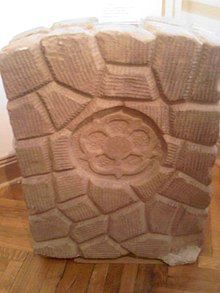
The coat of arms of the Free State of Lippe last showed the Lippe rose in a silver shield. The national flag was yellow and red. Both state symbols were adopted by the Lippe family .
The earliest coats of arms of the House of Lippe already showed the Lippe rose - but without sepals. Lippe carried this coat of arms in variations until 1947. In 1528, the star of Grafschaft Schwalenberg - a natural swallow on a golden (yellow) eight-pointed star - was added to the coat of arms. The early count's coat of arms depicted rose and star twice each in the four-part shield. In 1687, the four-field coat of arms of the Vianen and Ameide rulers in what is now the Netherlands, acquired through marriage (and sold again in 1725 due to financial difficulties), were included in the coat of arms of Lippe. The coat of arms recorded twice showed on the one hand three silver columns - later designed as mill iron crosses - black columns (coats of arms of those of Vianen), on the other hand a shield area divided five times by Feh and red, which in turn was the coat of arms of the Lords of Vianen around 1350 married burgraviate Utrecht was. The Feh was also interpreted as an iron hat in the Lippe coat of arms . The Sternberg county star was added twice later. In the center of the now nine-field coat of arms, the Lippe rose depicted only once, but lifted out in its own shield, moved as the family coat of arms of the Lippe family. The shield wears five helmets. It is held by two angels. The prince's rank symbolizes the prince's hat , which crowns a coat of arms surrounding the coat of arms.
A simplified coat of arms was used for the "official business" (stamp, seal, etc.). Mostly one limited oneself to the family coat of arms with the rose in the shield under a princely hat. Sometimes only the rose was shown without a shield. The trend towards simplification and the sole representation of the Lippe rose was also observed, for example, in coinage and on the coat of arms carved on the boundary stones.
population
The principality (1887: 1,215.20 km²) and the Free State (1925: 1,215.16 km²) counted
- 1783: ~ 67,000 inhabitants
- 1871: 111,135 inhabitants
- 1881: 112,452 inhabitants
- 1885: 123,212 inhabitants
- 1905: 145,610 inhabitants
- 1910: 150,937 inhabitants
- 1933: 175,538 inhabitants
- 1939: 187,220 inhabitants
For comparison: the current 1,246.29 km² area of North Rhine-Westphalia counts
- 2008: 355,178 inhabitants
religion
Under the influence of Hesse, the country joined the Reformation in 1538 and changed to Calvinism in 1605 (with the exception of the city of Lemgo ) . The Lippe Regional Church , one of two reformed regional churches within the EKD, still exists in Lippe . The Lutheran congregations, which predominantly exist in the larger cities, form their own church district (“class”) and are also part of the Lippe regional church.
economy

In addition to a textile industry based on the cultivation of flax and its processing into linen , the principality had a famous meerschaum pipe industry in Lemgo, a saltworks in Salzuflen (1878: 24,800 quintals of table salt ) and a wood industry that still exists today with numerous sawmills Raw material came from the country's vast forests. As in neighboring Prussia, the cigar industry also acquired particular importance , which, like the textile industry at first , was organized in a partly proto- industrialist division of labor in the publishing system . There were also beer breweries (including Strate and Falkenkrug ), brickworks , a sugar factory in Lage and oil mills . The largest industrial company was the Hoffmann's starch factories in Salzuflen . The Sinalco lemonade from Detmold achieved worldwide fame in the early 20th century .
The construction of the Lippische Bahn (1880) and the Lippische Nebenbahn (1895) were important for the industry, both of which ensured the connection to the main lines of the Cologne-Minden Railway Company . The Lippe state baths in Bad Meinberg and Bad Salzuflen and the saltworks in Bad Salzuflen also gained economic importance . Overall, however, Lippe was always an agrarian state, which was one of the economically weaker countries of the empire. Industry only existed to a small extent (for example, relative to the northern Ravensberger Land , which developed important linen, textile, tobacco and mechanical engineering industries with Prussian support) and, like the textile and wood industry, was based directly on the country's agricultural or forestry resources.
Among other things, this was a result of the great influence of the class and the monarch's not very business-friendly attitude at the beginning of industrialization. His economic interests lay primarily in securing his own economic power, which until recently resulted less from taxes than from the direct income of the princely domains, forests, salt pans and state baths. The Lippe migrant workers (→ Lippische Ziegler ) were a consequence of this economic weakness. This social problem is even mentioned in point 15 of the Lippische Punktation (1947). The North Rhine-Westphalian state government therefore promoted Lippe through the East Westphalia Plan, among other things . The loess-covered ridge landscapes in the Werre and Begatal at least enabled adequate agriculture. In the less fertile sand landscape of Senne, on the other hand, intensive agriculture was hardly possible. The keeping of grazing animals and the breeding of dairymen's horses at the princely hunting lodge Lopshorn became particularly important here .
currency
According to the Convention of 1752, the principality of Lippe had the thaler as its currency . 1 Taler = 36 Mariengroschen = 288 Pfennig = 576 Heller . In contrast to other areas, the Batzen and the Kreuzer did not exist as currency in the Principality of Lippe.
literature
- Erich Kittel: History of the state of Lippe. Home chronicles of the districts Detmold and Lippe (= home chronicles of the cities and districts of the federal territory . Volume 18 ). Archive for German home care, 1957, ZDB -ID 749758-1 .
- Wolfgang J. Neumann: The Lippe state. Where he came from - where he went . Neumann, Lemgo 2008, ISBN 978-3-9811814-7-0 .
Web links
- Digital collection of the Lippe State Library Detmold, subject area "Lippe"
- Internet portal “Westphalian History” - thematic and specialist portal on the history of Westphalia and Lippe
- Map of the Principality of Lippe German Historical Museum
- Regional association Lippe
- Information service for Lippe in NRW
- Lippe State Museum
- Rose country. Journal of Lippe History
- State ordinances and state laws of the County of Lippe
- Principality of Lippe (offices and municipalities) 1910
- Guidelines for the admission of the state of Lippe to the area of the state of North Rhine-Westphalia (Agreement between Prime Minister Dr. Amelunxen and State President Drake, "Lippische Punktation" on January 17, 1947)
- Circle lip
- The medals and decorations of the Principality of Lippe-Detmold on www.hausorden.de
Individual evidence
- ↑ Announcement of the Military Ordinance No. 77 of January 21, 1947 (PDF; 476 kB), reproduced on the lwl.org portal of the Westphalia-Lippe Regional Association, accessed on January 20, 2012
- ↑ Supplement to the Lippische intelligence papers 1783, pp. 121-131
- ↑ Meyers Konversationslexikon. Publishing house of the Bibliographisches Institut, Leipzig / Vienna, 4th edition, 1885–1892.
- ↑ www.woiste.de: The coins in the Principality of Lippe
Coordinates: 51 ° 56 ′ 10.3 " N , 8 ° 52 ′ 40.7" E
